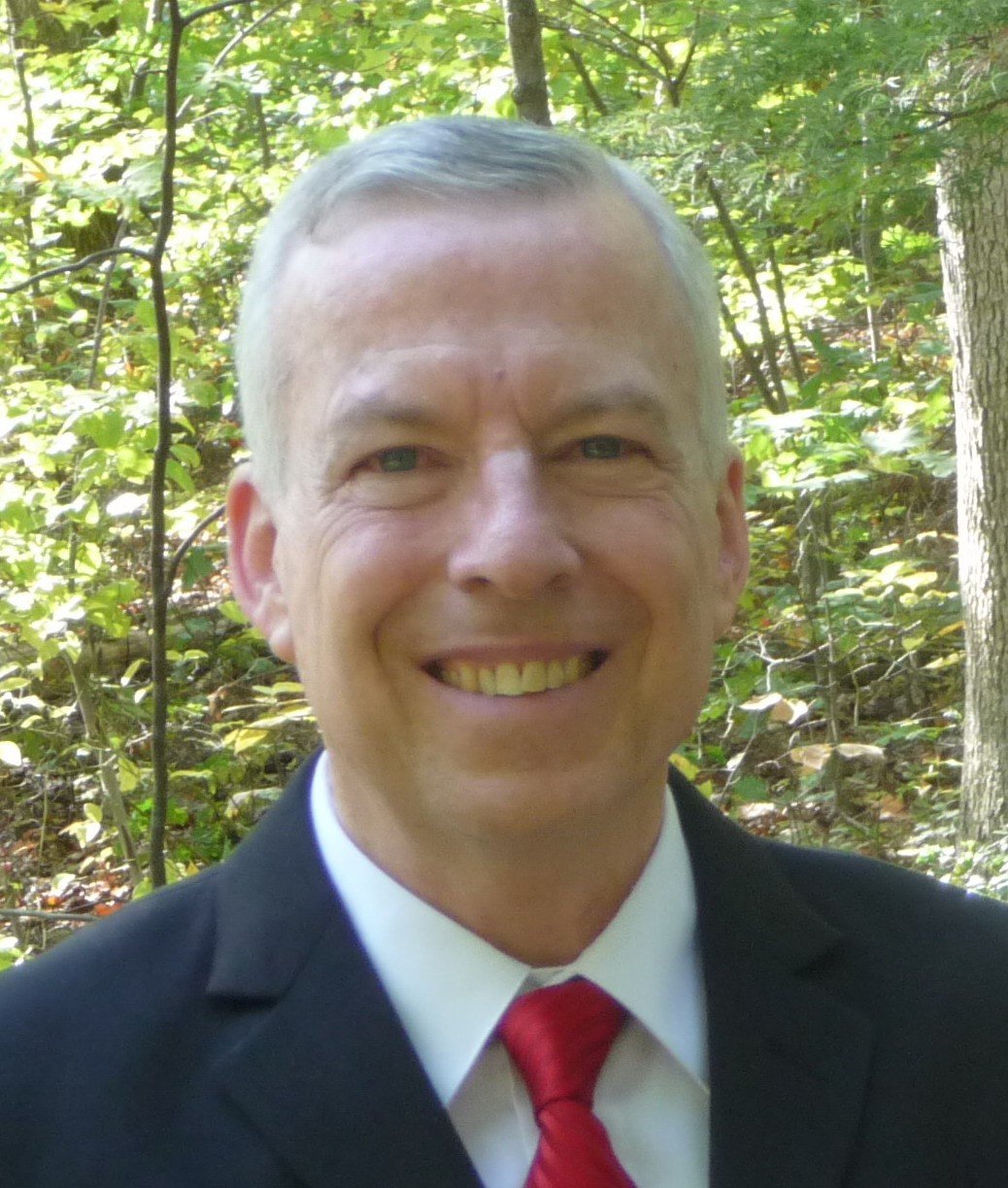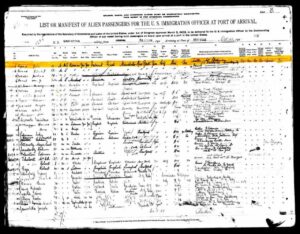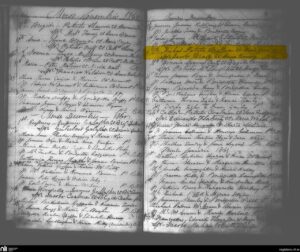In a previous Vita Brevis piece, I discussed the challenges faced in finding the immigration record of my great-grandfather Gerardo Smaldone, who emigrated to New York City in 1887 from the town of Potenza, Italy. In retrospect, that was a cinch compared to the search for the immigration of my Irish grandfather John Joseph Ryan.
I did find him after a daunting and tedious search, earning an unexpected bonus: his Ellis Island record revealed that an older sister was already here: Winifred Ryan had married Michael H. Spellman and had six children, with another on the way, when John arrived in late 1904. Recently, I found Winifred’s 1894 marriage record, with another bonus: the names of Michael’s parents. That sent me off on a hunt for his birthplace and family in Ireland.
Using Irish civil registration records that have been online only since 2016, and a research strategy I devised for the purpose, I was able to find them and add a new branch to my family tree. Thinking that this strategy would help others searching for ancestral localities and families in Ireland, I began writing it up … only to discover much simpler and faster methods using church records! Chagrined and embarrassed, I backtracked to figure out why and how I had gone wrong, and based on what I had learned, to formulate a new step-by-step method of locating ancestral Irish families and townlands using church and/or civil registration records. But relating that circuitous adventure would far exceed the normal length of Vita Brevis posts, so I reworked this humbling experience into a three-part series.
*
Let’s go back to the beginning, the laborious search for John Ryan’s immigration record. It didn’t help that Ryan is the eighth most-common Irish surname, and John the most-common male forename! Estimating that he emigrated between 1904 and 1908, I reviewed all 150 “John Ryan” Ellis Island records for that period, praying that he did not arrive earlier or later, or through another port! On 5 August 2002, after days of searching, I finally found him (near the end of that long list, of course!), having arrived on 28 October 1904. The only reason I was reasonably confident this was the right John Ryan was that he cited his older married sister Winifred Spellman as a relative living in Brooklyn.[1] That crucial bit of information – that he had a sister who married a Spellman – came from my mother’s last surviving sister, Veronica Ryan Farnan, when I asked her if any of her father’s relatives also immigrated to the United States. Unbeknownst to me or Aunt Vera at the time, it proved to be the only thing that made my grandfather stand out from the rest of those John Ryans![2]
At that time I didn’t know where the Ryans came from in Ireland...
I was now keenly interested in learning more about the Spellmans, hoping to track down some new cousins on Mom’s side of the family. But I didn’t get too far back then, in part because it was a common name. At that time I didn’t know where the Ryans came from in Ireland, nor where Michael H. Spellman, Winifred’s husband, hailed from. Years later I learned that the Ryans came from a rural area near the town of Boyle, County Roscommon, where my great-grandfather, also named John, was a “herd,” i.e., a shepherd who looked after a landlord’s livestock. I also learned that the six Ryan children were baptized in St. Joseph’s Church in Boyle.[3]
Quite recently, I returned to researching the Spellmans, hoping that records had become available online in the interim would facilitate the task. They had! Not only did I make great progress documenting the lives of my Brooklyn Spellmans and their descendants (Winifred and Michael had nine children), I also discovered the names of Michael Spellman’s parents (Patrick Spellman and Mary O’Gara) in the 1894 record of his church marriage to Winifred in New York City. That, of course, opened the possibility of finding his Irish roots.
But how? Every U.S. record that mentioned Michael’s place of birth stated only that it was in Ireland; until I knew the precise locality, I was stuck. As it turned out, my search for Michael and his parents in Ireland was not quite as laborious as searching for John Ryan’s immigration. After spending many hours over several days reviewing and cross-checking indexed Irish civil registration records online, I succeeded.
I felt proud of myself for having devised a search strategy that worked, but as research continued, I was embarrassed and frustrated to learn that searchable indexes to a comprehensive collection of Irish Catholic church records were also available online, on at least three genealogy sites – Findmypast, Ancestry, and www.rootsireland.ie – and that searching either Findmypast or Ancestry would have found them within minutes! In other words, the time and effort I put into devising and executing my “clever” search method to find Michael’s family in Ireland were unnecessary, and its potential value to other researchers was greatly diminished. Nevertheless, recounting this “learning experience” may benefit at least a few other researchers, offering a “plan B” to those who may, for whatever reason, fail to find their ancestors in the indexed Irish Catholic parish registers on the three above-mentioned sites.
*
So why did I go about this the hard way? Since I had the names of Michael’s parents and his approximate date of birth (December 1860, according to the 1900 census), I needed a plan to find either his parents’ marriage or his birth or baptism. Nationwide Irish civil registrations of births, marriages, and deaths since 1864, and non-Catholic marriages since 1845, are available online and can be searched, downloaded, and printed on the official Republic of Ireland Irish Genealogy website (https://www.irishgenealogy.ie/en/). Since I wasn’t sure when Michael was born, I first searched for his civil birth record just in case it was 1864 or later. I didn’t find it, and now knowing that his parents must have married before 1864 effectively ruled out further use of the civil records.
As for church records, I knew that digitized images of Catholic parish registers were accessible for free on the National Library of Ireland (NLI) website (https://registers.nli.ie/), but there is no index on that site, and I still had no idea which parish to search. Given my incomplete knowledge at that stage, the last option I envisioned was to search the nationwide civil death records from 1864 for Michael’s parents, and use a process of elimination and triangulation to co-locate the deaths of a Patrick Spellman and a Mary [O’]Gara in the same townland.[4] Then, after determining which Catholic parish included that townland, I could search the relevant parish baptism and marriage records on the NLI site or possibly on FamilySearch.[5]
My nationwide search of civil deaths for Patrick Spellman (using the “not exact” spelling feature) 1864-1930 produced 72 hits. I reviewed each record, ruled out most on the basis of age or bachelor status, leaving 25 candidates. I wrote down their ages, occupations, registration district, town or townland where they resided, and the name and relationship (if stated) of anyone who was present at their death or reported it to the registrar. Then, after confirming that married women were recorded by their married names in death registers, I searched deaths again 1864-1930, only for Mary Spellman, not [O’]Gara. This time there were 99 results; reviewing each and cross-checking to see if any died in the same registration district and locality as any of the 25 Patrick candidates yielded only one match: the townland of Lisserdrea in Boyle Registration District, which is in Boyle Civil Parish, Boyle Barony, County Roscommon, where “Pat Spelman” died in 1885 and his wife “Mary Spellman” in 1904.
The next step was to look for this promising couple and their family in parish records.
The next step was to look for this promising couple and their family in parish records. Upon determining that the closest Catholic church to Lisserdrea was St. Joseph’s in the town of Boyle, I was excited because my Ryan ancestors were also parishioners there! The families probably knew each other, so one wonders whether Winifred Ryan “ran into” Michael Spellman in New York or whether they had been in touch beforehand?[6] In any event, I began searching the Boyle parish baptism records on the NLI site but soon switched to FamilySearch, where navigation through the two digitized microfilms of St. Joseph’s registers was easier and faint/illegible images sometimes clearer. I was also pleased to discover that FamilySearch had indexed the first film (600+ images) with records from the early 1790s to 1864. I soon found the 15 December 1860 baptism of Michael born to Patrick Spellman and Mary Gara (the first names were in Latin).
Now certain that I had the right family, I worked backwards from 1860 in parish marriage records to find that of Patk Spollan[7] and Mary Gara on 18 October 1855. A further review of baptisms showed that this couple had eight children between 1856 and 1871. I used the film’s index to double-check my findings and to identify other promising records to examine. Filmed baptisms end in 1879 and marriages in 1881, so I used civil registration records to track marriages and descendants of the Spellman children, some into the mid-to-late-twentieth century. This added a batch of new people to my family tree.
Continued here.
Notes
[1] In 1897 immigration authorities began asking immigrants about relatives resident in the United States. My John Ryan’s passenger manifest named his sister as “Mrs. Spelman” at 517 Baltic Street in Brooklyn. Census records showed that her name was Winifred. She was the first sibling I discovered, which years later helped to identify their family in Ireland. I was intrigued that he sailed from Liverpool, England, his occupation was “barman” (bartender), and his previous residence was Manchester. Further research revealed that he had been a barman at the George and Dragon, a popular pub on Swan Street, and that the building, after multiple ownership changes and renovations, is still in existence as a well-known music venue! Ironically, and sadly, my grandfather, who drank too much, died in a Brooklyn bar in 1952. Over the years he worked in various shoe factories in Brooklyn. Winifred’s husband Michael was also a shoemaker, so perhaps he helped his brother-in-law find work in that business?
[2] Aunt Vera also mentioned that one of the Spellman children was murdered by the “mafia.” I recently found a series of newspaper articles confirming that in 1937 a masked assailant gunned down 27-year old John “Shirts” Spellman, a “policy racket collector,” at 4:30 one morning in a Brooklyn restaurant.
[3] Aunt Vera told me she thought her father might have come from County Roscommon. That tentative location was confirmed on John Joseph Ryan’s World War II draft registration and his Social Security application. But even knowing the names of his parents (John Ryan, Mary Byrne) from his Social Security application and 1952 death record, there were too many John Ryans in County Roscommon in civil birth indexes, which did not list parents’ names. The only other likely source for identifying his family was church records. There are more than 30 Catholic churches in County Roscommon, and I was not about to search all those haystacks!
In 2011, during a summer research trip to Ireland, I hired the County Roscommon Heritage and Genealogy Company in Strokestown, which had created a unique computerized database of church and civil registration records. I gave them the family names I had, and a few months later I received a full genealogical report on this Ryan family, tracing the descendants of John Ryan and Mary Byrne into the twentieth century. When Winifred Spellman died in 1936, her newspaper obituary stated that she was born in Boyle and named her deceased husband, her surviving children, and her siblings in Ireland, thus verifying the identities of the two families.
After learning that my great-grandfather John Ryan was a herd, I did some research and found that Irish historian John Cunningham wrote an article about the social and economic standing of herds in western Ireland. Unlike poor farmers and farm workers, herds were “a class quite distinct,” relatively well-compensated, enjoying high status, and often living in comfortable homes provided by their landlord. It was typically a hereditary occupation, but for whatever reasons my grandfather, the eldest son, chose to emigrate.
[4] Death records 1864-70 are not yet online, but detailed indexes are.
[5] John Grenham’s Irish Ancestors site (https://www.johngrenham.com/) states that FamilySearch has records for 398 of the 1,153 Roman Catholic parishes in Ireland. It should be noted that some church records of various denominations in Dublin City and Counties Kerry, Cork, and Carlow are also accessible on the Irish Genealogy website, along with links to other records and resources. There are, of course, other Irish church records or transcripts online elsewhere.
[6] I have not been able to find immigration records for Michael Spellman or Winifred Ryan. Although census records give various dates, most indicate that Michael came in the early 1880s and Winifred in the early 1890s. Unfortunately, the records at that time do not contain enough information to distinguish among multiple passengers sharing the same names.
[7] One might think that the name Spellman would not have too many spelling variations. However, the Boyle parish records had a surprisingly large variety: Spellman, Spelman, Speleman, Spallan, Spallen, Spillman, Spollan, Spollen, Spollin, and Spollon. The civil registration records show a similar range of variants. Researchers need to examine each carefully to determine if the same person’s name is spelled differently, or if they are different people with different family names. In the case of my “Patk Spollan,” his wife’s name and the baptism records of their children confirm that Spel(l)man is their correct family name.
Share this:

About Joe Smaldone
Joe Smaldone and his wife Judy Warwick Smaldone have been researching their family’s history for more than 20 years. Their research has taken them to many national, state, and local libraries, archives, court houses, churches, cemeteries, historical and genealogical societies, and other research sites across the United States, and abroad to Ireland, Italy, and Sweden. They are members of NEHGS and the New York Genealogical and Biographical Society. Joe was an adjunct professor at Georgetown University, where he created and taught a course entitled Your Family in History. He is a Genealogy Research Consultant at the FamilySearch Center, Annapolis, Maryland, and has published numerous genealogical studies, articles, abstracts, blog posts, and indexes.View all posts by Joe Smaldone →

